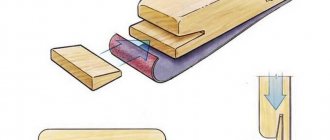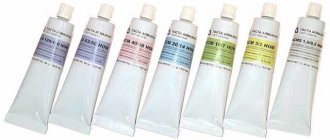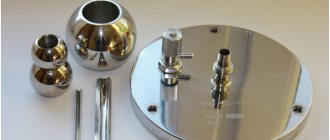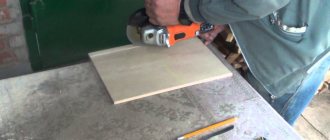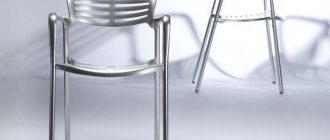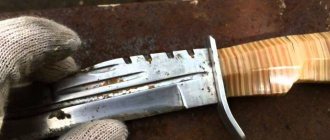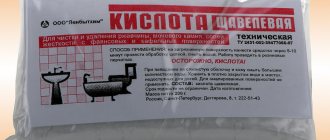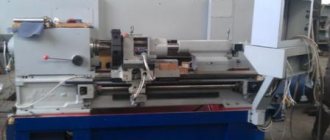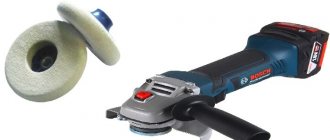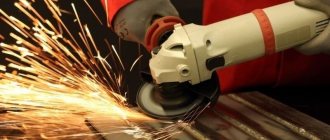The essence and features of the process
Flat grinding of metal is carried out on surfaces where there are no deep scratches and marks, because it is not possible to remove such types of damage using this method.
The most common method is to use an abrasive for parts that are large in size and have complex shapes. Another method involves grinding using grinding machines. Special wheels and polishing mixtures are used here.
Metal grinding is one of the types of processing using cutting. In this case, the processing allowance is removed with abrasive tools, namely grinding wheels. Their material is porous , consisting of numerous small grains, whose solids are abrasive materials. As the wheels begin to rotate, the edges of these grains begin to remove the smallest chips from the top or bottom of the material.
Sanding the material has some features that are important to consider during the process. These include the following points:
- The cutting speed must be high;
- Grinding and special type of metal shavings;
- The geometry of the cutting grains of the wheel should be multidirectional;
- A high temperature is generated in the area where contact with the surface occurs.
The surfaces processed when grinding metal are divided into simple and complex.
The first include the inner and outer surface in the shape of a cylinder, as well as a flat one. And by complex shape we mean helical and involute.
Metal polishing
To give the best consumer qualities and attractive appearance to metal products, a finishing grinding procedure is carried out. Polishing the metal gives the product a decorative shine; also, performing a similar procedure allows you to prepare the surface for applying various materials.
Metal polishing
Types of jobs
Metal polishing can be carried out using the following methods:
- mechanical or abrasive polishing of products;
- chemical treatment using special substances, for example, paste;
- electrochemical method;
- electrolyte-plasma method.
Some types of finishing sanding are simple and do not require special materials or equipment. For example, the mechanical method can be used at home. However, it is practically impossible to achieve significant results when using them.
Disadvantages of traditional methods
Polishing metal using traditional methods, abrasive and chemical effects on the surface, has a certain number of limitations in application. These include:
- lack of possibility to automate the process. When carrying out work to obtain gloss, many enterprises introduce automatic processing technology, which can significantly reduce the time it takes to obtain a whole batch. Chemical, mechanical, electrochemical polishing have features that make it difficult to automate the technological process;
- the difficulty of obtaining a mirror surface when using the considered types of impact on metal concerns technological and electrical reasons. Economic reasons are primarily associated with the high cost of production robots and machines that operate on a numerical control system. Technological factors determine the impossibility of incorporating traditional methods of polishing metal products to obtain a mirror surface.
Polishing stainless steel with a felt polishing disc
Often the above problems lead to the fact that the work in question is done by hand using a special paste under mechanical influence. This point determines a significant decrease in productivity, since processing on an automated line is impossible. Due to the use of outdated methods, the production line often results in a conveyor failure, and this negatively affects the cost of obtaining the product and reduces the competitiveness of the enterprise.
Mechanical polishing method
For many years, a mechanical method of processing the surface of a metal product has been used. Special sets of abrasive wheels and belts, when combined with GOI polishing pastes, make it possible to obtain a material with a roughness index Ra = 0.05–0.12 microns.
The features of this password encryption method include:
- to automate the process, special machines are used that are equipped with fabric or felt circles;
- a certain amount of GOI paste is applied to the abrasive;
- the goyi paste in question is a special powder consisting of an active substance that has an activating effect on the surface of the product;
- A typical paste consists of approximately 60% abrasive and 40% binder. content of activating additive 2%.
Finish grinding can only be achieved using GOI paste. In this case, a soft wheel and GOI paste with a fine abrasive are used. For such work, the material consumption is quite large: per 1 square meter of surface there are 0.3 felt wheels and an abrasive substance such as GOI, approximately 100 grams. When processing complex surfaces, a belt type of material and the same GOI abrasive are used.
Special attention should be paid to GOI paste. It is a special substance that is based on chromium oxide. The substance from the GOI category is produced in the form of a green bar. Special GOI sets contain bars with different abrasive grain sizes.
Chemical polishing
During chemical polishing, the surface is exposed to a combination of a specific substance and galvanic fumes. This process determines the formation of a passivating oxide film, which leads to the leveling of surface microroughness.
The quality of polishing depends on the ratio of the rate of film formation and its dissolution in the liquid. The highest gloss can be achieved by forming a thin film. With chemical polishing of metal, it is possible to achieve a film of thinner thickness than with electrochemical polishing, which determines the possibility of achieving better shine, but large irregularities in the part cannot be leveled out.
Electrochemical polishing
Electromechanical method
Mechanical and chemical polishing of metal often does not lead to the desired result. This is due to the fact that the product may have increased resistance to changes in structure. The electrochemical method is an exposure procedure that involves immersing parts in an electrolyte. Carrying out such work with your own hands is often quite difficult, since the electrolyte is represented by an acid solution. The impact occurs when the tank is connected to a power source with a voltage of about 20 V.
This type of processing determines the appearance of a passivating film, which leads to a decrease in the roughness index. The degree of change in the quality of the surface structure depends on the applied voltage. The achieved quality depends on the type of metal, the indicator of residual deformation, the thickness of the workpiece and other factors.
Electrolyte-plasma method
In recent years, the electrolyte-plasma processing method has become increasingly popular.
Grinding methods
Over the years, there have been various companies specializing in the processing of metal surfaces. The range of such works is very wide , but among the main types the following surface treatments should be highlighted:
- Center type cylindrical grinders. Grinding is carried out using wheels; the main objects are cylindrical and conical surfaces, as well as the ends of parts. Products of large length and cross-section are processed. The price of such work depends on the characteristics of the material and the specific service agreement;
- The use of centerless grinding machines is suitable for processing large-scale products. The rigid system promotes high processing speed and increased productivity. The product conforms to the dimensions specified in the order. Depending on the surface, such machines are used for internal and external grinding. The price is comparable to the order volume;
- Internal grinding is suitable for blind and through holes;
- As for external grinding machines, such devices use rotating abrasive wheels that fit tightly to the surface for grinding. The product itself is attached to a table that performs reciprocating movements. The particles located on the surface of the circle eliminate and protect the part from minor rust and shallow defects. Another advantage is the ability to process hardened surfaces. As a result, external grinding of small and large parts, as well as their polishing, is realized.
Various workshops and companies may carry out other types of metal surface processing. But the above methods are basic and ensure the elimination of defects and cracks. It is also very important to use grinding to give the material a decent appearance and increase reliability in the manufacture of the product.
Polishing metal to a mirror shine with your own hands
Stainless steel items have become a part of our lives. These are interior elements for the street and at home, various dishes at home and much more. Stainless steel is an alloy of iron and carbon mixed with special elements.
Steel acquires high resistance to negative environmental factors thanks to these elements. But under the influence of various factors, even such a durable metal can lose its original appearance.
How to polish to a mirror shine? If such a need arises, then you have two options:
- Contact a specialized company that provides this type of service.
- Do it yourself at home.
Let's look at how to polish metal to a mirror shine with your own hands in different ways at home.
Polishing at home
You can also get a shiny and smooth stainless steel surface at home. There are several ways that will help us with this.
Ordering services
order metal grinding from trusted companies that have been working in this field for a long time and have a large number of positive reviews. The master must have serious experience in processing various surfaces and products, and know the operating modes of the machine.
There are a lot of companies that provide metal grinding. However, finding the highest quality ones is not difficult. Every experienced manufacturer is interested in high-quality processing of products and therefore will turn only to proven options.
Metal polishing: types and methods of finishing the surface of metal products
The first three of the listed methods for treating metal surfaces have a number of application limitations. The main limitation for a number of industrial enterprises is the impossibility of automation when using mechanical, chemical or electrochemical methods for processing the surfaces of products in large batches of mass production.
Difficulties in using traditional types of metal polishing have both economic and technological reasons. Economic difficulties are associated with the high cost of production robots and CNC machines. The technological reasons for the difficulties in using traditional types of metal finishing are associated with the difficulties of building a fully automated production process.
The forced use of manual labor at the stage of polishing products, activating the surface or cleaning it does not allow for the smooth operation of industrial automated lines.
Often, due to the use of outdated metal processing methods, the production line takes the form of a conveyor, which significantly increases the cost of production and ultimately negatively affects the competitiveness of the products produced.
General idea of the design
In medicine, the term “prosthesis” is applied to structures designed to replace a missing body element or a specific organ.
In accordance with this definition, in dentistry, prosthetics involves placing a product in the oral cavity that will replace a lost tooth.
A denture is a fairly durable orthopedic product that replaces lost units of the dentition.
With its help, you can restore the external aesthetics, functionality, and anatomical characteristics of the dentofacial apparatus. When properly manufactured, it is practically indistinguishable in appearance from the anatomical elements of the jaw row.
Today in dentistry there are several types of prostheses, differing in type, method of fixation, material of manufacture and cost.
But all designs can be divided into two types.
Removable
These are orthopedic structures that a person can remove independently, for example, when performing daily hygiene procedures.
Designs are divided into two types:
- Full – recommended for installation in edentulous patients. They are attached by applying special creams to their surface or by a suction effect.
- Partial. The product is applicable if several of its own units are preserved in the mouth, which are used as supports for securing the prosthesis.
The most popular technology is clasp prosthetics. The clasp is a lightweight metal arch with a base and crowns attached to it. It is fixed to the supporting elements with clasps or miniature locks.
Fixed
The name itself indicates that it is impossible to remove them from the mouth on your own. They can only be removed by a specialist if there is evidence for it.
Fixed prosthetic structures are considered:
- A crown is a product that covers the entire or some part of the crown of a tooth. They can be either single or soldered. They differ in material from each other.
- Bridge prosthesis. It is similar in characteristics to crowns, is made of similar materials, but has a difference in the method of fastening, i.e. it is fixed to your own teeth, implants and adhesive structures.
- Microprostheses are special products that replace only a certain part of the tooth. These include veneers, lumineers and ceramic inlays.
- Fixed with implant fixation. This is a special type of permanent structure, when a rod is implanted into the jawbone, onto which an artificial crown is placed after 2-3 months.
The following materials can be used to make prostheses:
- acrylic resin;
- metal;
- nylon;
- metal ceramics;
- ceramics;
- special plastic.
A detailed description of the removable denture with Ivoclar teeth, its pros and cons.
Come here if you are interested in methods for classifying edentulous jaws.
At this address https://zubovv.ru/protezirovanie/semnyie-p/osnovyi-perebazirovki.html we will calculate the cost of relining a removable denture.
Reviews
Experts unanimously note the great importance of polishing prosthetic structures. The patients themselves indicate that after the procedure, the prostheses return to their original technical characteristics, discomfort disappears, and most importantly, their appearance is no different from natural units.
If you would like to express your opinion on the effectiveness and feasibility of this procedure, share them in the comments to this article.
If you find an error, please select a piece of text and press Ctrl+Enter.
Tags: denture polishing removable dentures
Did you like the article? stay tuned
No comments yet
